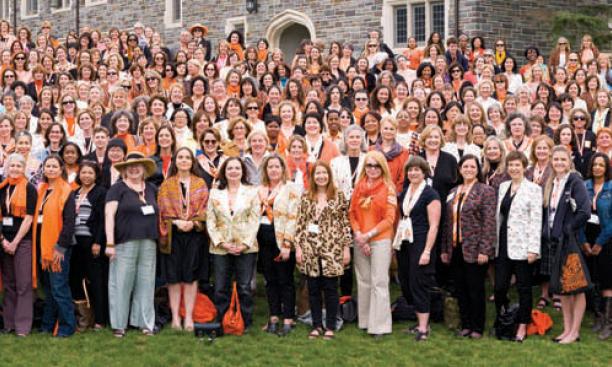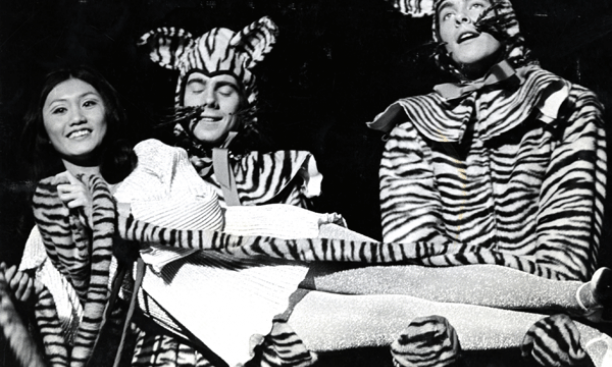

Caution,
On your guard with beautiful girls,
Flawless charmers every one.
This is how Samson was shorn;
Each in her style a Delilah reborn,
Each a gem, a beautiful
Diadem of beautiful –
Welcome them - these beautiful …
Girls!
As I’ve noted on occasion, this is a somewhat tougher job than it looks (aside from the obvious fact that the editors have pretty much given up trying to civilize me). Since the general topic is Princeton’s history, it’s often hard to convince fellow alums that the column is not intended as a paean to The Good Old Days. In fact, it’s somewhere on the opposite flank: To be even marginally successful, an institution of higher education must ceaselessly change, to the extent that whenever things are comfy, we should consider openly whether they are changing fast enough. Still, in times of normal (?) change, examples of past successful strategies to keep the denizens focused and motivated are helpful; in times of painful change, they are indispensable. We deal here in history and contemplation, not preservation. Our guiding light Fred Fox ’39 used the analogy of the river, never still, always moving; the mighty Mississippi remains and dominates, but its waters are never the same.
Being a numbers guy, I’ve noticed a change in the waters recently. Annual Giving last year had an eye-catching donation rate among undergrad alums of 61.3%, the highest in 42 years. But the next level of detail is what makes that achievement intriguing: the donation rate among the classes of 2001-2010 was 69.6 percent. You have to go back to the forebears of the ’40s and ’50s to find anything even remotely close. So what gives?
Princeton abolished its last student loans in January of 2001. Of the freshmen class then on campus, 40 percent were on student aid. The number for the current freshmen is 60 percent; that is indeed a startling change in 10 years. Princeton has utterly vanished from the lists of colleges whose students graduate with high loan balances; literally dozens of public colleges are higher, never mind the other private schools.
Perhaps what impresses me most is that, while the Class of 2002, the first to begin benefiting from the no-loan policy, donated at 69.2 percent last year, its just-missed-the-grants elders in ’01 gave at a hefty 67.8 percent rate. They clearly appreciated a good thing, even when they didn’t benefit directly. Here’s a locomotive for them.
Speaking of striking change, consider this: One day a woman will win the Class of ’23 Cane as the senior returning alum in the P-rade. (Don’t hold your breath, though: Malcolm Warnock ’25, the incumbent, is a robust 106 years old.)
Last spring, Princeton celebrated an earlier changing of the waters that laid the groundwork for that eventual day. In a conference with the admirably unambiguous label “She Roars,”the University made a good-faith effort to drag just about every alumna out from the shadows and celebrate 50 years of women at Princeton (in 1961, President Bob Goheen ’40 *48 had to personally go to the trustees to get one woman – Sabra Follett Meservey *64 *66 – admitted to the grad school). Captains of industry, Supreme Court justices, honored academics, giants of the not-for-profit world, piles of movers and shakers in the alumni community and governments around the planet, all showed up – to the tune of 1,400 women, more than two full classes’ worth – to consider the waters and discuss the river.

You can find much about the goings-on elsewhere here in PAW and from the University, but the meaning of the effort itself is intriguing (will there even be a need to hold such a conference in another 50 years?). It feels to me like a ceremonial Hail and Farewell: The hail part is self-evident, but the farewell element may be a bit more convoluted. It encompasses a view expressed vividly by the monumental Stephen Sondheim. For his unsettling Follies in 1971, he created a faux anthem about Beautiful Girls for a Busby Berkeley-like musical review from the ’20s; the ultimate verse you see above. Dripping with irony (written at the zenith of women’s lib), it portrayed a bygone image of unapproachable feminine allure and its dangers to the male of the species.
This stereotype is what women faced – or certainly felt they faced – at a macho outpost like Princeton in the ’60s, and the hearty band of alumna pioneers frankly deserved a fancy party on that basis alone, never mind all the subsequent success and honor.
The 171 undergrad women who showed up cold in 1969 took a calculated risk, and they deserve a special reward. But even among those, there were a handful who had every reason to think twice and question their own judgment beforehand; they already had been students at Princeton for a year, they knew the challenges, and yet they stolidly re-upped for The Great Experiment. The nine women of the Class of 1970 are a breed apart. Should one of them win the Class of ’23 Cane at some point, I would counsel the good folks at Reunions to expect her to wield it with assured authority, and a swift backhand.

It won’t be Sue-Jean Lee Suettinger ’70, though, who was featured at the top of PAW’s article on “She Roars.” Always a smiler who brought a bolt of energy into a room, Sue-Jean fell prey to leukemia over this past summer, the first of the nine women classmates to die, a melancholy milepost for the close group and the University. She was a groundbreaker even before being admitted – still a Critical Languages exchange student from the City College of New York at Princeton in 1968, she was the first woman ever to appear in Triangle, all alone. Dubbed “Clean Jean” by the raucous and likely petrified male dragsters, she devoted her limitless energy to the uncharted infiltration of male musical comedy, which she gamely recalled “helped me build my self-confidence and a “can-do” spirit.” By odd coincidence, I’ve always thought that the ultimate staging of Sondheim’s time-addled Beautiful Girls would include an all-out Triangle drag show (“faced with these Loreleis what man can moralize?”); now, whenever again I consider that perfect match of vanished cultures, I’ll imagine Sue-Jean right in the middle of it, playfully reminding everyone within earshot that the play’s the thing wherein to change the ethos of the king.
The eventual handover of the ’23 Cane to an alumna probably will be the transition point that all alums remember, when the University at last has undergone a complete passage of women through its lifecycle. Before then, let us hope that her eight sisters in the Class of ’70 and all the other alumnae have Sue-Jean’s opportunity to learn, to teach, and to hug her grandchildren; to relish the unique gifts that Princeton gave her and that she returned with interest.
And to listen while the ever-changing water in the river roars.
